308 scholarly books by CSLI and 20
have author last names that start with S
308 scholarly books by CSLI and 20
308 scholarly books by CSLI
20 have author last names that start with S have author last names that start with S
20 have author last names that start with S have author last names that start with S

Projecting Morphology
Louisa Sadler
CSLI, 2003
The separation of syntax and morphology is a major principle in contemporary lexicalist theories. The syntactic theory of Lexical-Functional Grammar recognizes this separation on a structural level but argues that both are equal, interacting, and competing contributors in a functional setting. This book discusses the relationship between morphology and LFG, reintroducing two seminal papers on the theory's impact on morphology and presenting new material on current morphological issues, including the nature of morphosyntactic paradigms and the role of optimality theory.
[more]
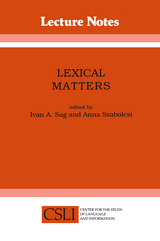
Lexical Matters
Ivan A. Sag
CSLI, 1992
This volume contains new research on the lexicon and its relation to other aspects of linguistics. These essays put forth empirical arguments to claim that specific theoretical assumptions concerning the lexicon play a crucial role in resolving problems pertaining to other componenets of grammer.
Topics include: syntactic/semantic interface in the areas of aspect, argument structure, and thematic roles; lexicon-based accounts of quirky case, anaphora, and control; the boundary between the lexicon and the syntax in the domains of sentence comprehension and nominal compounding; and the possibility of extending nthe concpet of blocking beyond the traditional lexicon.
Ivan Sag is a professor of linguistics at Stanford University. Anna Szabolcsi is an associate professor of linguistics at UCLA.
Center for the Study of Language and Information- Lecture Notes, Number 24
[more]
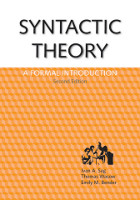
Syntactic Theory
A Formal Introduction, 2nd Edition
Ivan A. Sag
CSLI, 2003
This second edition of Syntactic Theory: A Formal Introduction expands and improves upon a truly unique introductory syntax textbook. Like the first edition, its focus is on the development of precisely formulated grammars whose empirical predictions can be directly tested. There is also considerable emphasis on the prediction and evaluation of grammatical hypotheses, as well as on integrating syntactic hypotheses with matters of semantic analysis.
The book covers the core areas of English syntax from the last quarter century, including complementation, control, "raising constructions," passives, the auxiliary system, and the analysis of long distance dependency constructions. Syntactic Theory's step-by-step introduction to a consistent grammar in these core areas is complemented by extensive problem sets drawing from a variety of languages.
The book's theoretical perspective is presented in the context of current models of language processing, and the practical value of the constraint-based, lexicalist grammatical architecture proposed has already been demonstrated in computer language processing applications. This thoroughly reworked second edition includes revised and extended problem sets, updated analyses, additional examples, and more detailed exposition throughout.
Praise for the first edition:
"Syntactic Theory sets a new standard for introductory syntax volumes that all future books should be measured against."—Gert Webelhuth, Journal of Linguistics
The book covers the core areas of English syntax from the last quarter century, including complementation, control, "raising constructions," passives, the auxiliary system, and the analysis of long distance dependency constructions. Syntactic Theory's step-by-step introduction to a consistent grammar in these core areas is complemented by extensive problem sets drawing from a variety of languages.
The book's theoretical perspective is presented in the context of current models of language processing, and the practical value of the constraint-based, lexicalist grammatical architecture proposed has already been demonstrated in computer language processing applications. This thoroughly reworked second edition includes revised and extended problem sets, updated analyses, additional examples, and more detailed exposition throughout.
Praise for the first edition:
"Syntactic Theory sets a new standard for introductory syntax volumes that all future books should be measured against."—Gert Webelhuth, Journal of Linguistics
[more]
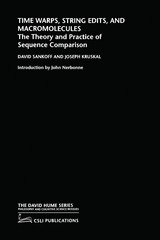
Time Warps, String Edits, and Macromolecules
The Theory and Practice of Sequence Comparision
David Sankoff
CSLI, 1983
Time Warps, String Edits and Macromolecules is a young classic in computational science. The computational perspective is that of sequence processing, in particular the problem of recognizing related sequences. The book is the first, and still best compilation of papers explaining how to measure distance between sequences, and how to compute that measure effectively. This is called string distance, Levenshtein distance, or edit distance. The book contains lucid explanations of the basic techniques; well-annotated examples of applications; mathematical analysis of its computational (algorithmic) complexity; and extensive discussion of the variants needed for weighted measures, timed sequences (songs), applications to continuous data, comparison of multiple sequences and extensions to tree-structures. This theory finds applications in molecular biology, speech recognition, analysis of bird song and error correcting in computer software.
[more]

Bricks and Mortar
The Making of a Real Education at the Stanford Online High School
Jeffrey Scarborough
CSLI, 2014
The rise of online learning is rapidly transforming how and what teachers teach, and even who—or what—teachers are. In the midst of these changes, the characteristics that have historically defined a high-quality education are easily lost. Not only content knowledge, but also ways of thinking and habits of mind are the hallmarks of the well-educated individual, and these latter qualities are not so easily acquired online. Or are they?
This volume shows how a group of online-learning believers built the best high school in the world without laying a single brick: the Stanford Online High School (SOHS). By chronicling SOHS’s distinctive approach to curriculum, gifted education, and school community over SOHS’s first seven years, Bricks and Mortar makes the case that the dynamic use of technology and the best traditional methodologies in education are not, in fact, mutually exclusive. Indeed, while SOHS has redefined what is possible online, a great education is ultimately the product of an interactive community of teachers and students.
This volume shows how a group of online-learning believers built the best high school in the world without laying a single brick: the Stanford Online High School (SOHS). By chronicling SOHS’s distinctive approach to curriculum, gifted education, and school community over SOHS’s first seven years, Bricks and Mortar makes the case that the dynamic use of technology and the best traditional methodologies in education are not, in fact, mutually exclusive. Indeed, while SOHS has redefined what is possible online, a great education is ultimately the product of an interactive community of teachers and students.
[more]
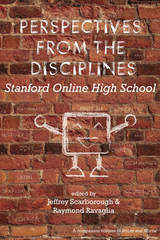
Perspectives from the Disciplines
Stanford Online High School
Jeffrey Scarborough
CSLI
In this companion volume to Bricks and Mortar, Jeffrey Scarborough and Raymond Ravaglia present a series of essays written by senior instructors and division heads at the Stanford Online High School (SOHS). Written from the perspective of the online-learning practitioner, these essays discuss in detail the challenges of teaching particular disciplines, accomplishing particular pedagogical objectives, and fostering the habits of mind characteristic of students who have received deep education in a given discipline. Perspectives from the Disciplines also examines counseling, student services, and student life viewpoints as it discusses how a truly international community has been fostered at SOHS, and how SOHS’s student relationships are in many ways deeper and more intimate than those found in traditional secondary schools.
[more]
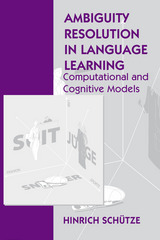
Ambiguity in Language Learning
Computational and Cognitive Models
Hinrich Schütze
CSLI, 1997
This volume is concerned with how ambiguity and ambiguity resolution are learned, that is, with the acquisition of the different representations of ambiguous linguistic forms and the knowledge necessary for selecting among them in context. Schütze concentrates on how the acquisition of ambiguity is possible in principle and demonstrates that particular types of algorithms and learning architectures (such as unsupervised clustering and neural networks) can succeed at the task. Three types of lexical ambiguity are treated: ambiguity in syntactic categorisation, semantic categorisation, and verbal subcategorisation. The volume presents three different models of ambiguity acquisition: Tag Space, Word Space, and Subcat Learner, and addresses the importance of ambiguity in linguistic representation and its relevance for linguistic innateness.

